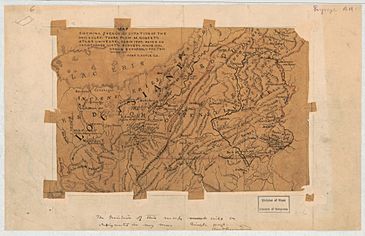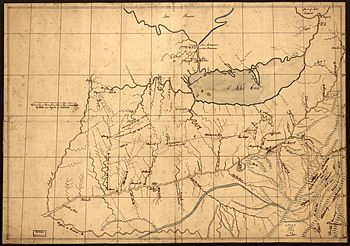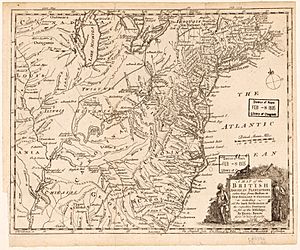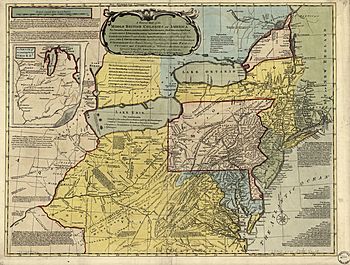Kuskusky facts for kids
Quick facts for kids
Kuskusky
Gas-Cagh-Sa-Gey
|
|
|---|---|
|
Historic Native American village
|
|
| Etymology: Iroquoian languages: koskohsh-ehtoh "at the falls, by the falls or rapids" Unami: kwësh-kwëshelxus-kee "hogs" + -kee (suffix used in place names) "Hogs Town" | |
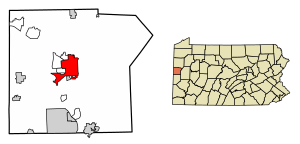
Location of the easternmost of the Kuskuskies Towns in Lawrence County, Pennsylvania
|
|
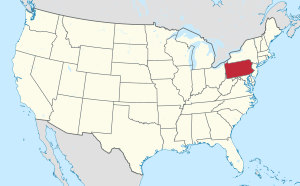
Location of Pennsylvania in the United States
|
|
| State | Pennsylvania |
| Present-day Community | New Castle, Pennsylvania |
| Founded | 1720 |
| Abandoned | 8 February, 1778 |
| Population | |
| • Estimate
(1758)
|
300-400 |
Kuskusky, also known as the Kuskuskies Towns, was a group of Native American villages. These communities were located near what is now New Castle, Pennsylvania, and also near Youngstown, Ohio. They existed in the mid-1700s.
Kuskusky was not just one town. It was actually three or four towns very close to each other. People from the Mingo, Lenape, and Seneca tribes lived there. The towns were built along the Beaver River. This was where its east and west branches, the Mahoning River and the Shenango River, met. Because it was a group of towns, people often talked about "the Kuskuskies" in the plural.
Contents
What Does Kuskusky Mean?
The name "Kuskusky" has a few possible meanings. One idea comes from a story told by Hugh Gibson in 1826. He was captured by the Lenape people. He said he lived in "Kuskuskin, or Hog Town." In the Unami dialect, kwësh-kwëshelxus means "hog."
Another idea is that the name comes from the Seneca word koskohsh-ehtoh. This means "at the falls" or "by the rapids." This might refer to the Beaver Falls, Pennsylvania area.
How Kuskusky Was Started
There was likely a settlement in this area as early as 1720. It was first settled by Lenape, Seneca, and Shawnee people. They moved west because European settlements were growing in the Susquehanna Valley. Also, there was less game to hunt there.
Later, challenges like a smallpox outbreak in 1733 and a dry spell in 1741 caused more groups to move to Kuskusky. Two Seneca villages with the same name were set up before 1742. One was at the mouth of the Shenango River. The other was at the mouth of Neshannock Creek.
English traders came looking for new sources of animal skins and furs. They set up trading posts. These posts attracted Native Americans who wanted European goods.
In November 1747, a Seneca leader named Kanuksusy traveled from Kuskusky to Philadelphia. He brought news about French activities in western Pennsylvania. He told the Pennsylvania Council that his group represented the Six Nations. He confirmed their neutrality during King George's War.
In April 1748, Nicholas Orontony and 119 Wyandot warriors, along with Miami warriors, attacked a French fort. After this, Orontony and his people moved to the Ohio Valley. Some settled at Conchake. Others went east to build a new town at Kuskusky.
Competition with Logstown in 1748
At this time, the colonies of Pennsylvania and Virginia were competing with France for control of the Ohio Country. This area was important for trade and travel. As war between Britain and France seemed likely, Native American tribes in the Ohio River Valley tried to stay independent. They also wanted to get valuable trade goods from the Europeans.
In 1747, Scarouady and other Iroquois leaders visited Philadelphia. They signed a treaty promising to help the British against the French. In return, they would get supplies and trade goods.
After attacking the French fort, Orontony and other Wyandot leaders had to seek an alliance with the English. Orontony wanted to make sure the English would offer military support and plenty of trade goods. The Native Americans were becoming very dependent on these goods.
As Tanacharison's influence grew, leaders in Kuskusky wanted to get Philadelphia's attention. They asked for a big meeting to be held in their town. However, Tanacharison said the Kuskusky Indians were not as important as others. The meeting was held at Logstown instead. In September 1748, Orontony and other Wyandot chiefs from Kuskusky met with the English representative, Conrad Weiser. They gave him a gift of beaver skins.
Another chief from Kuskusky, Canajachrera (also called Broken Kettle or Big Kettle), also met with Weiser. After Orontony's death in 1750, Canajachrera became the leader at Kuskusky. In late 1748, Pennsylvania sent 12 barrels of gunpowder to Kuskusky as a gift. This was a peace offering after their request to host the council was turned down.
Trade with English Traders
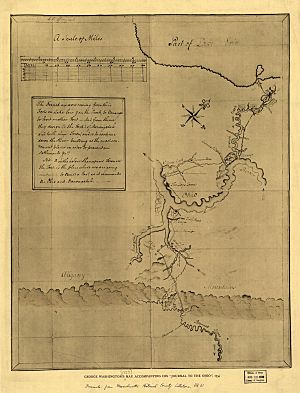
By 1748, English traders had set up posts in each of the Kuskuskies towns. This helped move some of the fur trade away from the French. There was a high demand for rum as a trade item. This sometimes led to disagreements.
Meeting with Céloron de Blainville in 1749
In the summer of 1749, a French officer named Pierre Joseph Céloron de Blainville led a group down the Ohio River. He was on a mission to claim the territory for New France. He buried lead plates and nailed copper plates with royal symbols to trees.
After stopping at an abandoned village, Céloron arrived at Logstown on August 8, 1749. That night, the French were warned that 80 warriors from Kuskusky were coming to help their allies. Céloron prepared for battle. However, the warriors appeared peacefully. A priest with Céloron wrote that the Native Americans saw the French were ready and numerous. They quietly left and greeted the French politely.
The French expedition was never attacked. However, there was always a chance of violence. The Native Americans chose not to attack. They did not want to risk bringing a stronger French military force into the Ohio country. They showed their disapproval by shooting holes in the French flag later. Céloron reported that the tribes in the area preferred the English. This led to the destruction of Pickawillany in 1752. It also led to France sending a large military force to build forts in 1753 and 1754.
The Kuskusky Path
After Fort Duquesne was built in 1754, the Kuskusky Path became important. This trail connected Kuskusky to the fort. Hunters, traders, warriors, and diplomats used it throughout the 1700s. The Kuskusky Path was seen as a continuation of the Great Shamokin Path. That path connected Native settlements at Shamokin (Sunbury, Pennsylvania) to Kittanning. The Kuskusky Path later became a paved road from New Castle to Pittsburgh.
Stories of Captured People
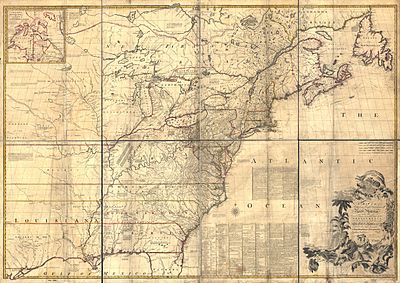
At the start of the French and Indian War, the British lost a big battle in July 1755. This left Pennsylvania without a strong army. Shawnee and Delaware warriors then launched many attacks on English settlements. They captured many people and destroyed communities. Kuskusky was used as a place to hold prisoners right after an attack.
Marie Le Roy and Barbara Leininger, both 12, were captured in October 1755. They were taken to Punxsutawney, Pennsylvania, then to Kittanning. After Kittanning was destroyed, they moved to Fort Duquesne. In spring 1757, the two girls were brought to "Kaschkaschkung, an Indian town on the Beaver Creek." They had to work hard, planting corn and doing other chores. They lived at Kuskusky for about 18 months. In August 1758, a missionary named Christian Frederick Post visited them, but they were not allowed to speak with him.
In October 1758, French and Native American forces lost a battle near Fort Ligonier. The people of Kuskusky then fled, taking the girls to Muskingum in Ohio. They escaped in March 1759. In their story, Marie Le Roy and Barbara Leininger listed 21 other people held at Kuskusky.
Hugh Gibson, 15, was captured in July 1756 by Lenape Indians. This happened near present-day Madison Township, Armstrong County, Pennsylvania. His mother was killed. He was taken to Kittanning and adopted by a Delaware chief. Gibson was living in Kittanning when it was attacked in September 1756. After the attack, he was taken to "Kuskuskin [Hog-Town] on the Mahoning." He lived in a tent outside Kuskusky. In March 1759, Gibson escaped with Marie Le Roy and Barbara Leininger and another English boy. They walked 250 miles to Fort Pitt.
Richard and Catharine Bard were captured in York County, Pennsylvania in April 1758. Six others were also captured, and their mill was burned. The prisoners were taken to Fort Duquesne. On the way, some were killed, and Richard Bard escaped. Catharine Bard was taken to Kuskusky. After a few days, she was moved to a nearby Lenape village. She lived there until her husband returned to pay for her release.
Peace Talks in 1758
After the attack on Kittanning in 1756, Native Americans who were neutral or friendly to the English moved to Kuskusky. Those who supported the French moved closer to Fort Duquesne. The English realized they needed Native American support to win the war. So, they started talks with Delaware leaders to get them to stop fighting.
Delaware chiefs wanted a treaty that would protect their lands. Pennsylvania's Deputy Governor asked Christian Frederick Post to negotiate at Kuskusky. Post knew the frontier well and spoke the Delaware language. He was trusted by the Delawares. He was told to offer forgiveness to all Delawares who had attacked Pennsylvania settlements if they would now support the British.
Post met with Pisquetomen and his brothers Shingas and Tamaqua at Kuskusky on August 12, 1758. Post described "Kushkushkee" as a large area about three miles long. He said it was "divided into four Towns, each at a Distance from the others." He estimated there were about 90 houses and 200 warriors. Post also saw French soldiers building houses for the Native Americans in the town. He noted that the French gave the Native Americans many goods, clothes, powder, and lead.
Post assured the Delaware leaders that the English wanted peace. He then visited other towns and returned to Kuskusky to discuss the Treaty of Easton. On September 6, he met the captured girls, Marie Le Roy and Barbara Leininger, but they did not speak. Post left Kuskusky on September 8 to talk to other tribes.
In October 1758, the Treaty of Easton was signed. This agreement was between British colonists and representatives of 13 Native American nations. These included the Iroquois, Lenape, and Shawnee chiefs. The treaty shifted power towards the British. It removed several important tribes from the fighting. This was one reason Fort Duquesne surrendered in November.
Memorial Plaque
A plaque was put up in 1925 at Slippery Rock, Pennsylvania. It remembers the 1758 treaty that Christian Frederick Post and King Beaver helped confirm. The plaque calls it "the most important treaty ever concluded with the North American Indians." It says the treaty "made possible the winning of the French and Indian War."
Later History of Kuskusky
Abandonment in 1759
The Kuskuskies Towns seem to have been mostly empty after 1758. The reasons are not fully clear. It might have been due to military actions at the end of the French and Indian War. Or it could be because English settlements were getting closer. Another reason might be a lack of game to hunt. Many Native American communities were moving farther west into the Ohio Country.
In February 1759, Colonel Hugh Mercer received a report about French troops near Kuskusky. Mercer then held a meeting with the Delawares at Fort Pitt. At this meeting, Tamaqua said the Delawares wanted to move to avoid fighting. He said they wanted to live in peace at Kuskusky or wherever they chose. Mercer agreed. In spring 1759, the Delawares moved from Kuskusky to communities on the Muskingum River and the Scioto River in Ohio.
Moravian Missionaries
In 1769, Custaloga brought a small group of Munsee people to Kuskusky. They wanted to be near English trading posts and a Moravian mission called Friedenstadt. However, the missionaries caused some disagreements. They did not allow alcohol and discouraged many traditional ceremonies. After Custaloga died in 1775, the community broke up. Many people returned to Ohio.
The Squaw Campaign in 1778
Kuskusky still had a small number of Delawares living there in the 1770s. In February 1778, General Edward Hand led a military action against the Seneca-Cayuga people. They were thought to have received weapons from the British. Hand led 500 soldiers to find Native American war parties. He did not find any. On their way back, the soldiers found a small group of Lenape Indians at Kuskusky. They attacked them, not knowing that the Lenape were neutral and at peace with the Americans. Among those killed were the mother and brother of Chief Hopocan, also known as "Captain Pipe." George Morgan, a Patriot official, later apologized to the Lenape.
New Kuskusky
The Delawares permanently left the Kuskusky site after 1778. After the American Revolutionary War, settlers moved into the area. In 1798, John Carlyle Stewart surveyed lands for veterans. He claimed about 50 acres where the Shenango River and Neshannock Creek meet. This was the site of the easternmost Kuskuskies town. For a short time, the town was called "New Kuskusky." The town of New Castle was named after New Castle, Delaware. It became a borough in Lawrence County by 1825. It had a population of 300 people then.
Archaeological Discoveries
Archaeological work in the Kuskusky area has found signs of human life from as far back as 16,500 years ago. The Pennsylvania Archaeological Site Survey has recorded 287 archaeological sites in Lawrence County. This means there is about one site for every 1.28 square miles. Forty-four of these sites are from the historic period, with remains from the 18th, 19th, and 20th centuries.
The State Museum of Pennsylvania has several items found at the Kuskuskies Town site. These include glass beads, a silver ornament with a deer engraved on it, and a fire starter set. These items were collected during an archaeological study in 1960.
Charles A. Hanna wrote in 1911 about the archaeology of the Kuskusky region. He said there was definitely a village where Edinburg now stands. This village was split into two parts. He noted that gun-flints, old bullets, gun parts, and bayonets have been found nearby. Many bones have also been discovered. Near the town was a burial ground with a mound. This mound was about 50 feet around and six feet high. When it was explored, it was found to contain several layers of human skeletons. Flat stones were placed around the bodies. Many flint chips and arrowheads have also been found in the area.


